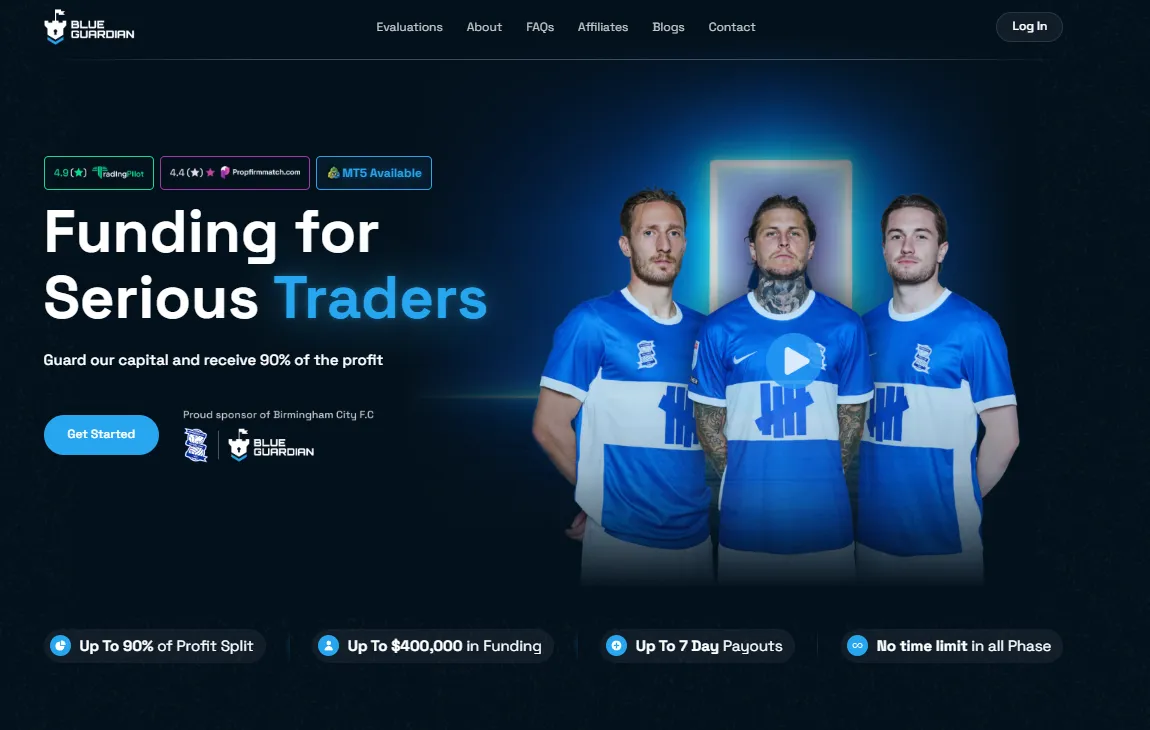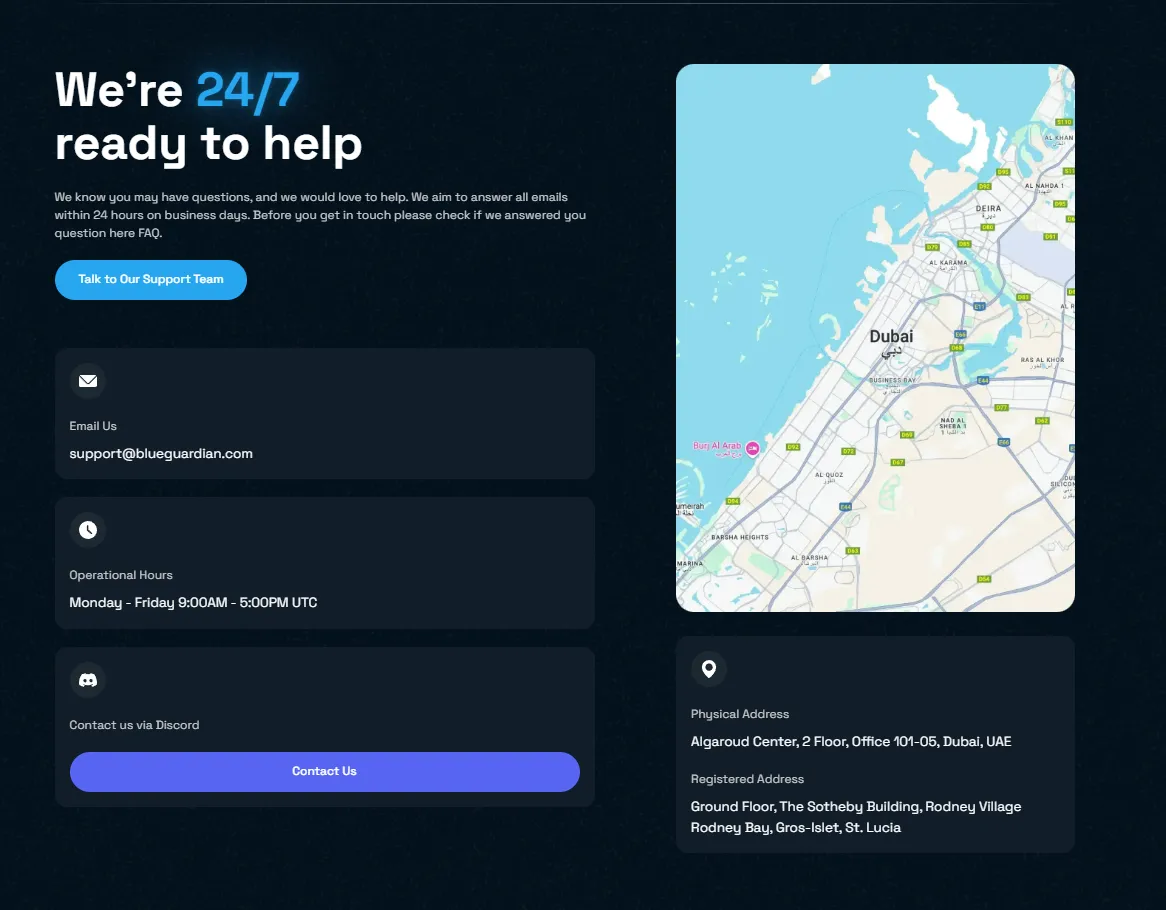 BrokerHiveX
BrokerHiveX BrokerHiveX
BrokerHiveX BrokerHiveX
BrokerHiveX Suspected of fraud
Suspected of fraudTime:1Year
| Company
Company Regulatory
Regulatory Risk Monitor
Risk Monitor Download
Download Documents
DocumentsBlue Guardian is a simulated trading evaluation platform headquartered in Saint Lucia. It claims to provide up to 90% profit sharing and fast withdrawal services, but in fact it is not a licensed broker and does not have any real fund custody qualifications. The platform only uses "Challenge Mode" as its core product and relies on MetaTrader 5 for internal simulated trading, but has not applied for any regulatory license, which poses serious compliance risks and credibility risks.
Blue Guardian's slogans include "Funding for Serious Traders" and "Instant Payouts", attempting to attract traders with low barriers and high profit sharing. However, the platform clearly states that it does not accept customer deposits, does not provide regulated financial services, and all operations are limited to evaluation tests in a simulated environment and cannot be converted into fund management in the real market.

Blue Guardian's operating entity is Blue Guardian Limited, registered in Saint Lucia with registration number 2024-00647. According to public information, the company was recently founded by CEO Sean Bainton, claiming to provide traders with fairer opportunities. However, apart from a brief introduction of the CEO, no further information on the management team's background, external financing records or historical performance has been disclosed.
From the perspective of brand development, Blue Guardian is not well-known in the industry and lacks any positive coverage from authoritative media. Although its official website lists payment credentials and social media screenshots to increase credibility, it does not provide verifiable third-party audits or long-term operating data, which casts doubt on the platform's sustainability and true business model.
The domain name blueguardian.com has been in existence for many years, but the brand has only been in use for a short time. The domain name registration information is private, the registrant and contact information are not disclosed, and the SSL certificate provider and security certification are not prominently displayed. This opaque operation greatly increases the difficulty for users to verify the authenticity of the platform.
Blue Guardian offers a variety of simulated trading challenges, including one-step, two-step and three-step evaluation modes, with entry funds ranging from US$5,000 to US$200,000, and profit sharing up to 90%, and claims to complete profit distribution through a fast withdrawal channel within seven days. However, all these so-called transactions are conducted in a simulated environment and do not involve liquidity matching and fund delivery in the real market.
Although the evaluation rules emphasize "no time limit" and "flexible trading style" in the publicity, the actual process still includes unilateral terms such as profit targets and drawdown limits. Even if the user completes the challenge, he can only continue to the next round of evaluation, and the simulation results cannot be converted into a real account under supervision.
In essence, Blue Guardian's business model is merely a paid internal simulation test, in which users bear all risks of rule changes and system failures, and it does not have any substantial fund custody or financial management attributes.
Blue Guardian relies on the MetaTrader 5 platform as the challenge execution environment, but does not connect to external liquidity providers. Tests by multiple independent media outlets show that the platform's transaction records and market data lack transparency, and it is impossible to verify the consistency of simulated prices with real market prices, posing the risk of "simulation optimization" or "data gold plating".
On the technical level, Blue Guardian's API is not stable enough, and occasional data delays and market packet loss seriously affect the backtesting and result migration of automated trading strategies. Due to the lack of a public service level agreement (SLA) and third-party monitoring mechanism, there is a great deal of uncertainty in the platform's system reliability.
Blue Guardian clearly states on its official website that it "does not engage in any regulated activities" and "does not accept customer deposits." Its only business is simulated trading evaluation projects. It does not hold any financial licenses and is not regulated by mainstream regulatory agencies such as the FCA, ASIC, and CFTC.
There is a lack of fund isolation custody, compensation fund and legal protection mechanism. Once there is an operational abnormality, evaluation interruption or withdrawal failure, the user's rights and interests will be completely unprotected. In addition, the official website disclaimer transfers all risks to users, indicating that the platform does not bear any responsibility, further highlighting its high-risk attributes.
The low threshold and high profit-sharing model promoted by the platform are very attractive to novice traders, but all profit distributions must deduct evaluation fees and platform fees, and there is a cooling-off period and hidden thresholds for withdrawals. Some users reported that Blue Guardian had experienced sudden changes in evaluation rules or system failures that led to interruptions in progress, and there were also delays or failures in withdrawal applications.
For traders who expect real money support, Blue Guardian's conditions are only at the simulation level, lacking any verifiable real money commitment. Participants often find that the actual benefits cannot be realized after completing the challenge, and the funds and time invested are ultimately difficult to be rewarded.

The Blue Guardian official website provides email and Discord channels as the main customer service channels, but lacks telephone support and a local office address. Many media and user complaints pointed out that the platform's customer service response speed is slow, and when encountering system problems or withdrawal disputes, they are often not resolved in a timely manner.
In terms of education and value-added services, Blue Guardian only provides basic guidance on challenging rules, and does not provide systematic trading education, market analysis or tool support like compliant brokers. The overall service quality and user experience are far below industry standards.

The essence of Blue Guardian's business model is a fee-based simulated trading challenge, which does not involve real market transactions or fund custody. The high profit sharing it advertises can easily mislead novice traders into thinking that "simulated profit = real profit", while the lack of supervision, variable rules, and opaque withdrawals put users at extremely high risk.
From the perspective of positioning, Blue Guardian is neither a compliant capital company nor a traditional broker or investment institution. It is just an internal evaluation platform packaged through marketing. For ordinary traders, participating in such projects cannot bring substantial financial support, but may face the double loss of funds and time.
From a comprehensive perspective, Blue Guardian has the following significant problems:
Lacking any financial licenses and regulatory qualifications, it is unable to provide user funds protection;
The simulated trading environment is not transparent, and the transaction data and prices lack authenticity verification;
The evaluation rules and withdrawal mechanism are unstable, and users complain about withdrawal difficulties and sudden changes in rules;
The technical platform is imperfect, with API data delays and frequent system failures;
Customer support channels are limited, service responses are slow and there is a lack of effective solutions.
Many authoritative media and industry blogs agree that Blue Guardian is only a business model in a simulated environment and cannot be converted into real fund management and market returns. Investors seeking stable financial support and a real trading environment should be cautious about such platforms to avoid taking unnecessary risks due to high-yield promises.
Answer:No, it is neither a real capital company nor a regulated broker. Blue Guardian is registered in Saint Lucia and is only a fee-based simulated trading evaluation platform. It does not hold any mainstream financial regulatory licenses such as FCA, ASIC, CFTC, and its official website clearly states that it "does not accept customer deposits and does not engage in regulated financial services." Its business is limited to trading challenges in an internal simulation environment and has nothing to do with real fund custody and compliant market matching. Therefore, user funds and rights are completely without legal protection.
Answer:The platform cannot cash out to the real market, and the income only stays at the internal simulation level. The "one-step, two-step, and three-step challenges" promoted by the platform are just paid internal tests. The maximum profit sharing of 90% seems tempting, but all transactions are completed on the simulation server, and do not involve real market liquidity, transactions, or fund delivery. Even if the challenge is completed, the so-called "funding support" is just to continue the next round of simulation evaluation. The user's simulation results cannot be converted into a real account that can be supervised. A large number of users reported that the withdrawal application was delayed or even failed.
Answer:Poor reputation, slow customer service response, and almost no channels for rights protection. Blue Guardian mainly provides customer service through email and Discord, without a phone number or physical office address, and responds slowly when encountering system failures, withdrawal disputes, and other issues. Users on platforms such as Trustpilot have complained about problems such as opaque withdrawals, arbitrary changes to evaluation rules, and system data delays. Due to the lack of supervision and third-party arbitration, even if users encounter disputes over funds and rules, they cannot protect their rights through formal channels.
After depositing funds, their MT5 server kept disconnecting, causing me to miss trades and incur losses, and their support just blamed my Internet connection
![]() Reply
Reply
My withdrawal request took over a month to process, during which they demanded endless additional documents and tacked on hidden fees
![]() Reply
Reply
They claim to be regulated, but I couldn’t find any license information—feels like a shell company pretending to be legitimate
![]() Reply
Reply
Customer service is virtually non‐existent; sometimes it took them 24 hours or more just to reply to a simple question
![]() Reply
Reply
Their advertised high‐rebate promotion turned out to be non‐withdrawable credit only usable against future fees—totally misleading
![]() Reply
Reply
I never imagined I’d see my money again after being scammed. The whole situation felt hopeless until a friend recommended Mrs. Nora. I reached out to her, shared my case, and carefully followed her guidance. To my surprise, everything was recovered within just three days. It still feels surreal, but I’m beyond grateful. If you’ve ever been in my shoes, don’t give up—Mrs. Nora is someone you can truly trust. 📧 Email: bruce.nora254(@)gmail.com | 📱 WhatsApp: +1 (8 7 0) 810 54 42
![]() Reply
Reply
~ There's nothing more ~